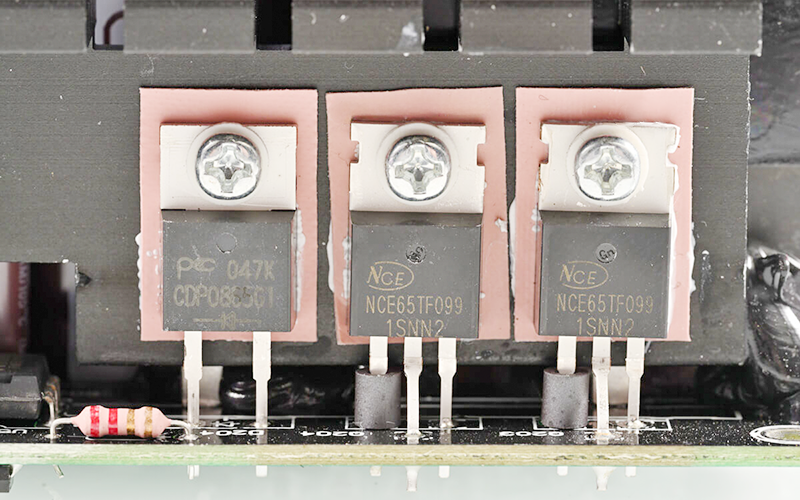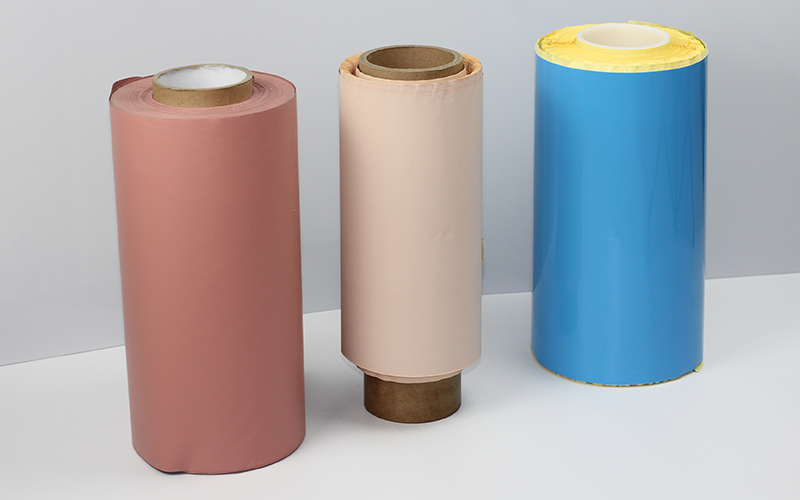Electrically Insulating Thermal Sheet for Efficient Heat and Electrical Protection
- Posted on:2025-04-30 15:43:00
- Source:AOK Thermal Pad Manufacturer FAQs
Have you ever wondered why high-power power supply modules can run safely without overheating? Or how the power control system of electric vehicles maintains stability under high-voltage conditions? Behind these industrial-grade electronic devices, there's often a humble yet critical component—electrically insulating thermal sheets.

1. Concept of Electrically Insulating Thermal Sheets
Electrically insulating thermal sheets are the "invisible guardians" in the field of power electronics. Made from materials like silicone, fiberglass, or polyimide film, they are processed into sheets through techniques such as coating or casting. The key feature of these materials is their ability to meet two seemingly contradictory requirements: thermal conductivity and electrical insulation. They help dissipate heat from power semiconductor devices like IGBTs and MOSFETs while providing essential electrical isolation to prevent high voltage from causing damage to the system.

2. Working Principle: The Art of Balancing Contradictions
Imagine that when a power module or industrial control system is running at full load, the temperature of the semiconductor components can quickly rise. Without proper heat dissipation, these components may not only lose performance but could even get damaged due to overheating.
Electrically insulating thermal sheets serve as the "intermediary" between the power components and the heat sink:
- On one hand, they efficiently transfer the heat generated by the power semiconductor devices to the heat sink through their excellent thermal conductivity.
- On the other hand, their outstanding insulating properties block high voltage, protecting the system from electrical faults.
When placed between the heat source and the heat dissipation components, these sheets fill microscopic gaps on the contact surface, reducing thermal resistance and significantly improving heat dissipation efficiency, all while ensuring electrical safety. This dual thermal conductivity and electrical insulation feature resolves a critical issue in the design of electronic devices.
3. Common Types: Each with Its Strengths
Polyimide Film Electrically Insulating Thermal Sheets
These sheets use polyimide (commonly known as "PI film") as the base material, combined with thermally conductive silicone rubber. They are like the "tough guy" in electronic devices, capable of stable operation in extreme environments:
- Wide operating temperature range: -60℃ to 180℃
- High breakdown voltage: up to 6.0kV
- Excellent processability: easy to die-cut and install
- Long service life: outstanding weather resistance and radiation resistance
These materials are especially suitable for high-end applications that demand both insulation performance and temperature stability, such as servers and medical devices. Aochuan Technology'sTCK series PI film electrically insulating thermal sheetsare tailored for high-performance applications, providing superior heat dissipation and electrical insulation, making them widely used in demanding power electronics devices.
Fiberglass Electrically Insulating Thermal Sheets
Fiberglass-based sheets are like the "tough warriors" in electronics, made from glass fiber combined with thermally conductive silicone rubber:
- High mechanical strength: tear and puncture resistant
- Good dielectric strength: ensuring electrical safety
- Wide adaptability: temperature range from -60℃ to 200℃
- Cost-effective: popular in scenarios where cost sensitivity is important
These materials are often used in products that require reliable performance at a reasonable cost, such as household appliances and general power modules. Aochuan Technology'sTC series fiberglass electrically insulating thermal sheetsoffer excellent cost-effectiveness, widely used in medium-to-high power supplies and industrial tools, providing effective heat dissipation and electrical protection.
4. Applications: Ubiquitous Heat Management Experts
With the rapid development of power electronics technology, the power density of power devices is increasing, making the use of electrically insulating thermal sheets more critical. These sheets work quietly in various fields, such as:
- LED Lighting: In high-power LED systems, these sheets help dissipate heat from light-emitting elements, extending their lifespan and maintaining stable luminous output.
- Power Modules: In high-power switch-mode power supplies, industrial power supplies, and inverters, these sheets serve as a "safety bridge" between power components and heat sinks, ensuring efficient heat transfer and preventing high-voltage breakdowns.
- Semiconductor Devices: In high-power semiconductors like IGBTs and MOSFETs, electrically insulating thermal sheets allow these "high-power electronics" to operate at full capacity without overheating.
- Automotive Electronics: In electric vehicles, these sheets are crucial for temperature management and electrical safety in battery management systems (BMS) and power control systems, improving system reliability.
- High-Power Equipment: In large power converters, UPS power supplies, and server power systems, these sheets are key components that ensure stable, long-term operation by preventing overheating of power components.
- Industrial Control Systems: In industrial equipment that operates continuously, these sheets are essential for maintaining reliability, ensuring that devices do not fail due to overheating and indirectly ensuring production safety.
5. Comparison with Other Thermal Materials: Each Has Its Strengths
Several thermal materials are available in the market, each with its advantages and best-use scenarios:Electrically Insulating Thermal Sheets vs. Thermally Conductive Silicone Sheets: Silicone sheets excel in heat dissipation but have weaker insulating properties. On the other hand, electrically insulating thermal sheets balance both thermal conductivity and electrical insulation, making them the better choice when both are needed.
Electrically Insulating Thermal Sheets vs. Thermal Phase Change Materials:Phase change materials excel at absorbing heat during temperature fluctuations. However, they don't prioritize electrical insulation. If your application demands long-term stable operation and electrical safety, electrically insulating thermal sheets are the better option.
6. Manufacturing Process: Artistry in Creation
Making a high-quality electrically insulating thermal sheet is like crafting a fine dish, requiring precise procedures and expert craftsmanship. The typical steps include:
- Raw material selection: Choosing high-quality substrates like silicone or polyimide film
- Formula adjustment: Adjusting the types and ratios of thermally conductive fillers based on the application
- Coating/Extrusion: Applying or casting the material evenly onto the base material
- Curing: Using heat treatment or other methods to cure the material
- Die-cutting: Cutting into various shapes and sizes as needed
Each step affects the final product's performance, and only refined manufacturing processes can ensure that the electrically insulating thermal sheets perform optimally in real-world applications.
7. Market Prospects and Development Trends: Thriving Growth
With the rapid development of renewable energy, electrified transportation, and industrial automation, the demand for electrically insulating thermal sheets is growing significantly. Key areas of growth include:
- Renewable Energy: Devices like photovoltaic inverters and wind converters require higher-performance thermal insulation materials.
- New Energy Vehicles: The power conversion systems and motor drivers in electric vehicles need reliable thermal management and electrical protection.
- Industrial Automation: High-power drivers and control systems have an urgent need for efficient heat dissipation.
- Power Grid Equipment: Power control devices in smart grids need superior thermal insulation solutions.
As power semiconductor technologies such as SiC (silicon carbide) and GaN (gallium nitride) continue to advance, electrically insulating thermal sheets will face higher demands for temperature and heat dissipation performance, driving continued market growth.
8. Environmental Features: A Green Technology Representative
With growing global environmental awareness, the environmental performance of electrically insulating thermal sheets is also under increasing scrutiny:
- RoHS compliance: Free from harmful heavy metals like lead, mercury, and cadmium
- Halogen-free design: Some products are designed without halogens, reducing environmental pollution
- Recyclability: Developing materials that are easier to recycle is a key industry focus
As environmental regulations become more stringent, more eco-friendly electrically insulating thermal sheets will become the mainstream choice, pushing the electronics industry toward a more sustainable direction.
9. Conclusion
Electrically insulating thermal sheets are the "unsung heroes" in power electronics. Though inconspicuous, they play a critical role in modern industrial and energy technologies. Through their unique dual properties of thermal conductivity and electrical insulation, they effectively solve the heat dissipation and electrical safety challenges faced by power semiconductor devices, ensuring stable and efficient operation.
With continuous technological advancements, these materials will keep innovating and developing, providing strong support for more efficient and reliable power electronics systems in the future. When choosing electrically insulating thermal sheets, selecting the right type based on specific application needs can improve device performance, extend service life, and reduce system failure rates.

